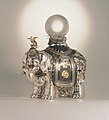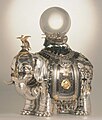Delwedd:Khalili Collection Japanese Meiji Art M072.jpg

Maint llawn ((2,500 × 2,742 picsel, maint y ffeil: 1.18 MB, ffurf MIME: image/jpeg))
Daw'r ffeil hon o Comin Wikimedia a gellir ei defnyddio gan brosiectau eraill. Dangosir isod y disgrifiad sydd ar dudalen ddisgrifio'r ffeil yno.
Crynodeb
Object
| Incense Burner (Koro)
|
|||||||||||||||||||||
|---|---|---|---|---|---|---|---|---|---|---|---|---|---|---|---|---|---|---|---|---|---|
| Teitl |
Incense Burner (Koro) |
||||||||||||||||||||
| Object type |
censer |
||||||||||||||||||||
| Disgrifiad |
English: A silver koro modelled as an elaborately caparisoned elephant with a richly embellished harness comprising a bejewelled saddle-cloth bearing shishi masks and minogame, supporting a coiled dragon standing on swirling clouds holding a large rock-crystal ball. The creature's headdress in the form of a stepped base upon which stands a gold ho-o bird with its wings spread. The whole carved and applied in shakudo, shibuichi, gold, silver, and a shakudo-copper mokume alloy. Details of the caparison are inlaid in rock crystal, malachite, coral, tiger's-eye, agate, and nephrite. It is interesting to consider the symbolism in this object, for it gives an insight into a spiritual aspect of the Japanese character at the time of the Meiji Restoraion as well as exemplifying Japanese aspirations abroad. The white elephant is an animal of great significance in Buddhism. It is the mount of the Bodhisattva Fugen, while his brother bodhisattva rides a lion-like beast called a shishi. They are the bodhisattvas of wisdom and are said to have been born during the lifetime of the historical Buddha. The elephant was one of the animals present at the death and final enlightenment of the Buddha. The elephant has a saddle in the form of a lotus, which, being symbolic of rebirth, is the throne for all holy beings in Buddhism. On the throne is a cloud upon which rides a coiled dragon, a messenger of Buddhism representing almighty power. The cloud signifies that the dragon exists in a realm beyond the heavens. The dragon supports a crystal ball, which in popular legend represents a jewel that controls the tides. In this case the crystal, by its clarity and brightness, represents the essence of Buddha's teaching, and it is thus a replacement for the bodhisattva who usually rides the elephant. The saddle-cloth bears faces of the shishi, which guards holy beings and whose roar expresses the power of Buddha's law. Below the shishi are, on one side, the minogame, turtles trailing waterweed behind them, and on the other a crane, both symbolizing longevity and associated with Chinese immortals. The stylized scrolling on the caparison can carry either lotus flowers or the flowers of the Bo-tree, under which the Buddha became enlightened. The phoenix forming a crown on the head of the elephant is the most auspicious of creatures, flying through the realm of Buddhism and representing the joy of Buddha's law. Stylized magic coats from among the auspicious objects associated with the Seven Deities of Fortune hang from the caparison and alternate with bells along the bottom edge of the saddle-cloth. The ringing of bells is to dispel illusion, and represents the spiritual awakening of Buddhism. Thus, the elephant is a messenger of Buddhist wisdom. |
||||||||||||||||||||
| Dyddiad |
circa |
||||||||||||||||||||
| Casgliad |
institution QS:P195,Q63160499 |
||||||||||||||||||||
| Rhif catalogio | |||||||||||||||||||||
| Place of creation |
Japan |
||||||||||||||||||||
| Cyfeiriadau |
https://www.khalilicollections.org/collections/japanese-art-of-the-meiji-period/khalili-collections-japanese-art-of-the-meiji-period-incense-burner-m72/ (Saesneg) |
||||||||||||||||||||
Ffotograff
| Awdur | Khalili Collections | ||
| Caniatâd (Ailddefnyddio'r ffeil hon) |
|
||
| Diwygiadau eraill |
|
Trwyddedu
- Mae'n rhydd i chi:
- rhannu – gallwch gopïo, dosbarthu a throsglwyddo'r gwaith
- ailwampio – gallwch addasu'r gwaith
- Ar yr amodau canlynol:
- cydnabyddiaeth – Mae'n rhaid i chi nodi manylion y gwaith hwn, rhoi dolen i'r drwydded, a nodi os y bu golygu arni, yn y modd a benwyd gan yr awdur neu'r trwyddedwr (ond heb awgrymu o gwbl eu bod yn eich cymeradwyo chi na'ch defnydd o'r gwaith).
- rhannu ar dermau tebyg – Os byddwch yn addasu'r gwaith hwn, neu yn ei drawsnewid, neu yn adeiladu arno, mae'n rhaid i chi ddosbarthu'r gwaith dan drwydded sy'n union yr un fath same a'r gwreiddiol.
Captions
Items portrayed in this file
yn portreadu
Incense Burner (Koro) Saesneg
Incense Burner (Koro) Saesneg
Hanes y ffeil
Cliciwch ar ddyddiad / amser i weld y ffeil fel ag yr oedd bryd hynny.
| Dyddiad / Amser | Bawdlun | Hyd a lled | Defnyddiwr | Sylw | |
|---|---|---|---|---|---|
| cyfredol | 16:37, 12 Tachwedd 2020 |  | 2,500 × 2,742 (1.18 MB) | MartinPoulter | Opened and saved in IrfanView to fix colours |
| 15:38, 12 Tachwedd 2020 |  | 2,500 × 2,742 (974 KB) | MartinPoulter | pattypan 20.04 |
Cysylltiadau'r ffeil
Nid oes tudalennau'n defnyddio'r ffeil hon.
Metadata
Mae'r ffeil hon yn cynnwys gwybodaeth ychwanegol, sydd mwy na thebyg wedi dod o'r camera digidol neu'r sganiwr a ddefnyddiwyd i greu'r ffeil neu ei digido. Os yw'r ffeil wedi ei cael ei newid ers ei chreu efallai nad yw'r manylion hyn yn dal i fod yn gywir.
| Deiliad yr hawlfraint |
|
|---|---|
| Lled | 2,500 px |
| Uchder | 2,742 px |
| Cynllun cywasgu | Heb ei gywasgu |
| Cyfansoddiad picseli | Ar wahân (CMYK efallai) |
| Gogwydd | Normal |
| Nifer y cydrannau | 4 |
| Datrysiad llorweddol | 350 dpi |
| Datrysiad fertigol | 350 dpi |
| Trefn y data | fformat talpiog |
| Meddalwedd a ddefnyddir | Adobe Photoshop CS6 (Macintosh) |
| Dyddiad ac amser y newidiwyd y ffeil ddiwethaf | 16:04, 11 Rhagfyr 2018 |
| Gofod lliw | Heb ei raddnodi |
| ID unigryw y ddogfen wreiddiol | adobe:docid:photoshop:ff4e8bc5-b625-11d8-9722-da647cc13c31 |
| Dyddiad ac amser y digido | 13:00, 2 Mehefin 2004 |
| Y dyddiad y newidiwyd y metadata ddiwethaf | 16:04, 11 Rhagfyr 2018 |
| Statws yr hawlfraint: | Hawlfraint |




